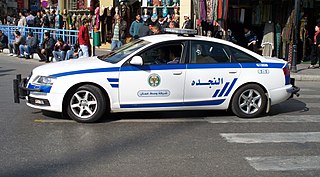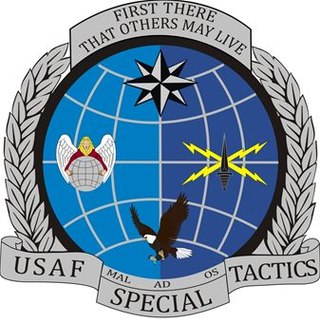
Close-quarters combat (CQC) or close-quarters battle (CQB) is a close combat situation between multiple combatants involving ranged or melee combat. It can occur between military units, law enforcement and criminal elements, and in other similar situations.

The PIT maneuver or TVI is a pursuit tactic in which a pursuing vehicle forces a fleeing vehicle to turn sideways abruptly, causing the driver to lose control and stop. It was developed by BSR Inc. and first used by the Fairfax County Police Department in Virginia, United States. Other interpretations of the acronym "PIT" include pursuit immobilization technique, pursuit intervention technique, parallel immobilization technique, precision intervention tactic, and push into traffic. The technique is also known as tactical ramming, legal intervention, and fishtailing.
The multiple integrated laser engagement system, or MILES, is used by the U.S. military and other armed forces around the world for training purposes. It uses lasers and blank cartridges to simulate actual battle.

Joint Expeditionary Base–Little Creek (JEB–LC), formerly known as Naval Amphibious Base Little Creek and commonly called simply Little Creek, is the major operating base for the Amphibious Forces in the United States Navy's Atlantic Fleet. The base comprises four locations in three states, including almost 12,000 acres (4,900 ha) of real estate. Its Little Creek location in Virginia Beach, Virginia, totals 2,120 acres (860 ha) of land. Outlying facilities include 350 acres (140 ha) located just north of Training Support Center Hampton Roads in Virginia Beach and 21 acres (8.5 ha) known as Radio Island at Morehead City, North Carolina, used for U.S. Coast Guard ships and personnel as well as serves as an amphibious embarkation/debarkation area for U.S. Marine Corps units at Marine Corps Base Camp Lejeune, North Carolina. It is also home to the Naval School of Music.

King Abdullah II Special Forces Group, commonly known as the JORSOF are strategic-level special forces of the Royal Jordanian Army under the Jordanian Armed Forces. Founded on April 15, 1963, on the orders of the late King Hussein, its primary roles include reconnaissance, counter-terrorism, search and evacuation, intelligence gathering combat, and the protection of key sites. The Special Forces Group are also charged with carrying out precision strikes against critical enemy targets. The unit is equipped and trained to be able to operate behind enemy lines for long periods without any logistical support, and is considered some of the best in the Middle East.

Flight controllers are personnel who aid space flight by working in such Mission Control Centers as NASA's Mission Control Center or ESA's European Space Operations Centre. Flight controllers work at computer consoles and use telemetry to monitor various technical aspects of a space mission in real-time. Each controller is an expert in a specific area and constantly communicates with additional experts in the "back room". The flight director, who leads the flight controllers, monitors the activities of a team of flight controllers, and has overall responsibility for success and safety.

The People's Liberation Army Special Operations Forces (中国人民解放军特种部队) are a special operations force of the People's Liberation Army.

Naval Surface Warfare Center Crane Division is the principal tenant command located at Naval Support Activity Crane. NSA Crane is a United States Navy installation located approximately 25 miles (40 km) southwest of Bloomington, Indiana, and predominantly located in Martin County, but small parts also extend into Greene and Lawrence counties. It was originally established in 1941 under the Bureau of Ordnance as the Naval Ammunition Depot for the production, testing, and storage of ordnance under the first supplemental Defense Appropriation Act. The base is named after William M. Crane. The base is the third largest naval installation in the world by geographic area and employs approximately 3,300 people. The closest community is the small town of Crane, which lies adjacent to the northwest corner of the facility.

The Royal Jordanian Army is the ground force branch of the Jordanian Armed Forces (JAF). It draws its origins from units such as the Arab Legion, formed in the British Mandate of Transjordan in the 1920s. It has seen combat against Israel in 1948, 1956, 1967, and 1973. The Army also fought the Syrians and the PLO during Black September in 1970.

Operations Specialist is a United States Navy and United States Coast Guard occupational rating. It is a sea duty-intensive rating in the Navy while most of Coast Guard OS's are at ashore Command Centers.

The Jordan Design and Development Bureau (JODDB) is a Jordanian defence company. The company was established by Royal Decree as King Abdullah Design and Development Bureau (KADDB) on 24 August 1999 to provide an indigenous capability for the supply of scientific and technical services to the Jordanian Armed Forces (JAF). JODDB was also created for the supply of defense and commercial equipment optimized for Middle East requirements. It is an independent agency within the Jordanian Armed Forces tasked with operating according to best business practices and is financed both through the defense budget and by technology, products and services sales incomes.

Law enforcement in Jordan is the purview of the "Public Security Force", the Jordanian national police, which is subordinate to the Public Security Directorate of the Ministry of Interior.

The Bureau of Indian Affairs Police, Office of Justice Services, also known as BIA Police, is the law enforcement arm of the United States Bureau of Indian Affairs. The BIA's official mission is to "uphold the constitutional sovereignty of the Federally recognized Tribes and preserve peace within Indian country". It provides police, investigative, corrections, technical assistance, and court services across the over 567 registered Indian tribes and reservations, especially those lacking their own police force; additionally, it oversees tribal police organizations. BIA services are provided through the Office of Justice Services Division of Law Enforcement.

The Special Forces Qualification Course (SFQC) or, informally, the Q Course is the initial formal training program for entry into the United States Army Special Forces. Phase I of the Q Course is Special Forces Assessment and Selection (SFAS). A candidate who is selected at the conclusion of SFAS will enable a candidate to continue to the next of the four phases. If a candidate successfully completes all phases they will graduate as a Special Forces qualified soldier and then, generally, be assigned to a 12-men Operational Detachment "A" (ODA), commonly known as an "A team." The length of the Q Course changes depending on the applicant's primary job field within Special Forces and their assigned foreign language capability but will usually last between 56 and 95 weeks.
The ADMS is an emergency and disaster management training simulation system designed to train incident commanders, first responders, and incident command teams in a real-time, interactive virtual reality environment. ADMS was first introduced by Environmental Tectonics Corporation (ETCC:US) in 1992. The development of ADMS was in response to the crash of British Airtours Flight 28M at the Manchester airport in 1985, in which 55 people died. Following the accident research indicated that first responder training should include realistic scenarios. The first ADMS system was produced for the UK Ministry of Defence, and delivered to Royal Air Force's (RAF) Manston Facility. Since its inception, ADMS has evolved into a modular, expandable disaster simulation platform, with systems in use worldwide.

The Chocolate Mountain Aerial Gunnery Range (CMAGR) is a bombing range operated by the US Marine Corps located in southern California.

Neutral buoyancy simulation with astronauts immersed in a neutral buoyancy pool, in pressure suits, can help to prepare astronauts for the difficult task of working while outside a spacecraft in an apparently weightless environment.

A United States Air Force Special Tactics Officer is a United States Air Force Special Operations Command (AFSOC) Special Warfare Officer who manages the training and equipping of U.S. Air Force ground special operations. Special Tactics Officers deploy as team leaders or mission commanders in combat, seizing and controlling airstrips, combat search and rescue, guiding airstrikes and fire support using air assets for special operations and tactical weather observations and forecasting. Special Tactics Officers are not Pararescuemen, Combat Controllers, or Special Reconnaissance, but they lead the Special Tactics Squadrons and Groups and thoroughly understand how to conduct, manage, and provide these special operations missions to both conventional and joint special operations missions needed within Joint Special Operations Command (JSOC) and United States Special Operations Command (SOCOM).

Rapid reaction forces are brigade-strength forces with high combat readiness, immediate response speed, flexible and highly mobile that are able to operate independently, within Jordanian forces, or with friendly and allied forces to defend Jordanian national security within the borders of the Kingdom of Jordan or Outside in all circumstances at the time and place and in accordance with the orders of the General Command of the Armed Forces.
The 104th Operational Maneuvers Regiment is a special forces regiment of the Algerian Land Forces, and is also a parachute regiment.




















